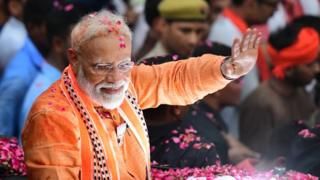Election 2019 – Layers Into Modi Victory
May 30, 2019 • 60 views

On 23rd May 2019, India voted for Prime Minister Narendra Modi with a massive mandate of 303 seats, crossing the half-way mark required to form the government. After 1971, this is the first government to get a majority in it’s second term. On the other hand, India’s oldest party, Indian National Congress-led by Rahul Gandhi gets only 52 seats in the Parliament, failing to become leader of the opposition for the second time. According to the constitution, a party needs to secure at least 10 percent of the votes, to become leader of opposition and Congress has got less than 3 seats to get that title in the Parliament. While it is great for BJP, not for democracy. Every democracy needs an opposition, and when there is no opposition, there is no criticism and that is a worrying situation. But, before we get deep into the role of the opposition, let’s break down what exactly led to victory of the BJP –
Leadership
In 1971 General Elections, when Indira Gandhi came back to power with a majority it was the leadership quality that she showed time again from Green revolution to 1971 Bangladesh war. Even after emergency the government that was formed, the leaders within the government admitted the need for her leadership. Similarly, Prime Minister Modi represents to the people similar leadership quality. Though India does not have a Presidential Election, the election of 2014 and that of 2019 was fought on personality basis. But, is that a justification? No. Despite being a parliamentary democracy, just like Australia and United Kingdoms even we have Prime Ministerial candidates fighting to be the leader of their country’s Parliament. But, India does not only have national parties but also regional parties, therefore, it has a negative effect for India’s development when the centre has all the power to itself, since regional imbalance in India is a huge problem. Therefore, coalition government is always better for India then a party with a full majority in the Parliament.
What all worked in Modi’s favour, is the lack of leadership in the opposition. When asked who should we vote for other than Modi, anyone opposing lacks an answer to an alternative to them. Rahul Gandhi is out of question, and from past experience that Third Front cannot go on for a full term. Therefore, his win was inevitable.
Hindutva
India has always been a very religious country, and extremely traditional. Indians have always valued culture more than education, freedom and justice. But, despite these entrenched belief within Indians since pre-Independence, we still had a secular republic as our leaders on the top who were extremely educated, rational and as some might call now, elitist decided to take high moral and ethical ground and promote inclusiveness, reasoning, people’s will and socialism as the key to move our independent country forward. But, as our country grew, merit took it’s turn and people from lowest strata of society rise up to become something great in life. But, the thinking at the bottom still remains traditional and religious. Therefore, when they rise up the ranks without rationality, and education. It can create serious issues when they run the government. This can be seen with Modi’s rise to power, who got that sub-conscious hate in the minds of Indians to consciousness, creating an unhealthy atmosphere in the country.
Pragya Thakur who is a terror-accused was given a ticket to fight elections from Bhopal to fight against Digvijay Singh who coined the term ‘Hindu terror.’ Yashwant Sinha, Former Finance Minister said in a interview that the seat of Bhopal will decide where India wishes to go, it wants social harmony, or Hindu-Muslim divide. Now that elections are over, Bhopal seat has gone to Pragya Thakur, it is a clear-cut symbol of what the country is going to look like in the future. India clearly has chosen division over social harmony and unity.
Houses, LPS, Jan Dhan Accounts and Toilets
With opening of bank accounts, it gave a chance to the government to transfer money in the poor man’s account directly in order to help him/her to make a toilet, or a house. Many people in rural areas credited Prime Minister Modi for these schemes, and help them with basic necessities that have been lacking in rural areas. Another thing that worked in his favour was the LPG connection, telling a lot of people in urban areas who with education has come up in the system decided to give up subsidy when the Prime Minister asked them to, so that he can give it to those people who actually require the LPG subsidy. It led to many people in rural areas getting LPG subsidy, but even in this case the first person to get the resources were upper castes.
National Security
Even though on defence front, Prime Minister Modi did not do something great. What did help him was that he created an image of stateman after Balakot airstrikes. Something similar to what Vajpayee and Indira Gandhi did in order to reach to that level of acceptance by the people. The only difference here is that the two other personalities never used Kargil War or 1971 War for Bangladesh as way to garner support. It was sub-consciously added in people’s mind. Narendra Modi, literally, during campaign asked people to vote for him on these lines, calling himself a statesman rather people seeing him as one.
